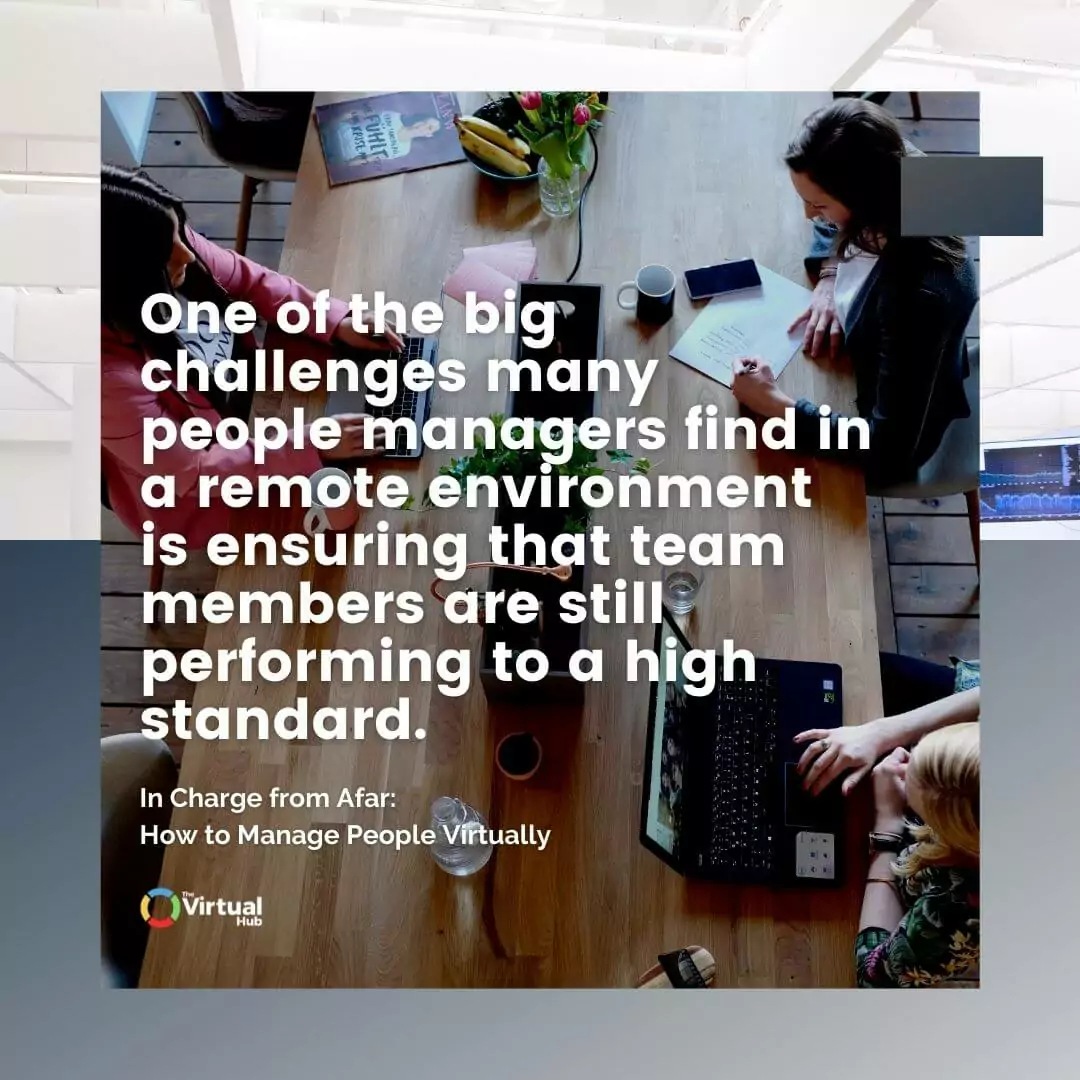People management is a perennial challenge for managers in all industries. But when you manage different people virtually, those challenges take on a whole new element! Many aspects are just like what you will find in a co-located worksite, except you have to deal with them effectively in a remote environment.
You could say that the first challenge is finding the right people to work remotely. While virtual work has become more and more common, it’s also a fact that not everyone is suited to a remote position. Some people just do better in a physical workplace. This means that you need to find the self-starters, the ones who can stay energized remotely, and aren’t bothered by not having someone physically there.
But once you have the right people onboard, you’ll still be faced with a few common challenges of people management in a virtual setting. Let’s look at some of those, and some strategies for working through them.
RELATED: 3 Steps In Overcoming The Challenges Of Managing Virtual Teams
Managing People Effectively in a Virtual Workplace
You can click on these links below to jump on a specific section:
What Are the Management Skills Needed for Effective Management?
Whether you’re managing direct reports in a virtual workplace or a physical one, there are certain leadership skills you'll need to be a successful manager:
Communication Skills
Good managers in a virtual workplace understand the power of communication. They know that they need to be clear and concise when communicating with their employees. And they make sure to keep the lines of communication open at all times.
Organizational and Time Management Skills
You need to be organized and have good time management skills. This is especially important in a virtual workplace, where there can be distractions and interruptions that can throw off your entire day. You need to have the ability to stay focused and on task, and keep your entire team on track as well.
Effective Delegation Skills
You need to be able to delegate effectively. This is a challenge in any worksite, but it can be especially difficult in a virtual environment.
When you’re not in the same physical space as your team, it can be harder to keep track of who is working on what and how they are progressing.
Conflict Resolution Skills
Conflict is inevitable in any workplace, but it can be magnified in a virtual environment. When you’re not able to see body language and other nonverbal cues, it can be easy for miscommunications to happen. And when people are spread out all over the world, time zone differences can add an additional layer of complexity to conflicts.
Trust-Building Skills
You need to be able to trust your team. This is essential in any workplace, but it’s especially important in a virtual environment. When you can’t see what your team is doing, you need to be able to trust that they are working and not slacking off.
Which Management Style Works Best When Managing People Virtually?
There is no one “right” management style for effectively managing people in a virtual setting. The best approach is to use a mix of styles, depending on the situation.
Here are some common management styles that can be effective when managing people virtually:
Laissez-Faire
The laissez-faire style is all about giving your team members the freedom to work how they want, when they want. This style can be effective in a virtual environment because it allows employees to manage their own time and work schedule.
However, this style can also lead to problems if team members start to abuse the freedom and slack off.
Autocratic
The autocratic management style is all about centrally controlled decision-making. This style can be effective in a remote setting because it allows you to have more control over the team’s work. But it can also lead to problems if employees feel like they are not being given enough freedom to do their job.
Democratic
The democratic style is all about giving team members a say in decisions that affect them. This style can be effective in a virtual environment since it allows employees to feel like they are a part of the decision-making process.
However, this style can also lead to problems if team members start to feel like their input is not being valued.
RELATED: Managing Virtual Teams By Setting Expectations Right
Paternalistic
The paternalistic management style is all about protecting and providing for your employees. Because this style helps team members feel like they are being taken care of, it can be effective in a virtual environment. However, it can also lead to problems if employees start to feel like they are being micromanaged.
How Do You Deal With Challenges When Managing People Virtually?
Assuming a management role in any workplace comes with a set of challenges that must be addressed in order to be successful:
Challenge #1: Managing Communication
When managing people virtually, there’s no such thing as “management by walking around”, or any of those other common theories of management for the office environment. You can’t look over someone’s shoulder and you can’t casually drop a suggestion on your way by.
All of your communication needs to be undertaken by using modern technology in some way.
Options such as email, video chat, telephone, chat app, and project management tools need to be assessed and used effectively, since these options can cause the biggest of communication challenges.
For instance, if email inboxes are increasingly getting crowded, messages might get missed. Chat apps can also become too “noisy” if they’re not successfully managed. All of this is before you even get to the actual messaging!

Another core challenge is the effective communication and interpretation of the message.
It is so easy for messages to get misinterpreted when people have to go by the actual words. In real life, we rely on all sorts of non-verbal cues to understand messages. However, tone of voice and body language aren’t available in an email!
This is why it's important to know how to actively manage people using smart communication methods. Here are some quick tips for managing communication effectively in a virtual environment:



Consider Which Channels You’d Like to Use and How to Use Them to Their Best Advantage
Make sure that your team knows which communication channels to use, for what and when. For example, a quick “what times do you have available on Wednesday?” message is easily communicated via chat because it probably doesn’t require a lot of back and forth.
On the other hand, if you’ve got a bunch of instructions for a new project, these might best be communicated in your project management tool, where it is easy for people to refer back to the message.
Have Documented Procedures That Are Stored Somewhere For Quick And Unlimited Access
If you’re working virtually, there is often a lag between someone asking a question and them getting the answer that they need. This is why if you need to explain how to use a certain tool, or what process to follow with a certain client, having it documented helps to avoid repeating yourself. It also allows for team members to solve problems on their own.



Use video to communicate more complex messages (such as instructions for how to use a tool or program). Screen share videos can be an excellent replacement for sitting next to someone in-person.
Provide Feedback via Phone or Video Chat
If you’re having performance issues with an employee, actually chatting with them in real time can help to avoid misinterpretation of an email. It also shows your employees that you care enough to take the time to talk.
Consider the communication channels you’d like to use and use them to their best advantage.
Challenge #2: Gaining Trust
When you work together in an office, you often build up the trust of your team by being present, managing standards consistently, and making expectations clear. You'll know how to manage people well when you trust your employees, and you can do this by getting to know them, building camaraderie, and seeing the results of their work.
In a virtual environment, there needs to be that two-way system of trust and mutual respect as well. Without these, there’s a good chance that you won’t work together effectively and that you’ll end up with high turnover.



Here are some tips for gaining trust:
Be Consistent about Enforcing Expectations and Standards
Have them documented and easily available. If there is a company policy about what happens when a deadline is missed, enforce that policy consistently across the whole team.
Be sure to also make it clear that you don’t expect people to be working at all hours.
Sometimes, people who work remotely can feel like another cog in the wheel--it’s up to you to make it clear that people aren’t expected to work nights and weekends, or to respond to messages within five minutes.
The most successful virtual businesses tend to have communication policies that expect a response within 24 hours on a weekday. This helps to keep things realistic and ensure that people don’t feel tied to their desks. It sends the message that you care about your team members.
Consider the Things Which Make You Feel Comfortable in a Workplace and Trusting of a Good Manager
If you’re told things in confidence, keep them that way.
Additionally, demonstrate that you trust your team to get on with the job. Checking in every hour won’t help with productivity and only says that you think they need constant “managing.”



Some managers struggle with the idea that someone can be very productive outside of an office environment. If this is you, do your best to put that aside. Remember, time spent “at work” doesn’t necessarily equate to productivity.



Challenge #3: Maintaining Productivity
Maintaining productivity is a key skill when you want to ensure how to manage people successfully. This is universal, whether a team is remote-based or in an office.
Productivity begins by having the right systems and tools in place.
As much as possible, look to standardize an ongoing process so that it becomes second nature to your team. It’s much easier for someone to complete tasks efficiently when they follow the same process every time.
At the same time, not being too rigid about things that aren’t super-important can help your team to be more productive.
As an example, remote-based employees usually work from home or a co-working space. The expectation is usually that there will be some flexibility around work hours, although obviously if you have reason to require people for certain times, that’s a bit different.
The fact is that every person is different in terms of when their most productive hours are.
Some people are not “morning people” at all. However, those same people might power through the work later in the day when they’re feeling more energized. Some people are the opposite--they’d prefer to start early then relax in the afternoon.
If you have the flexibility to allow people to work during their most productive times, it often helps with the quality of the outputs.
Here are some other tips for productivity:
Productivity in remote teams is facilitated by having the right systems and tools in place.
Use Document Systems Which Allow for Easy Access for Those Who Need It
You should easily be able to implement “version control” on documents and see the change history. This helps to ensure everyone has the most up-to-date information and that nothing is changed by mistake that can’t be easily rectified. (Good examples of this are cloud-based systems such as Google Docs).
Have KPIs or Output Goals That You Can Track
This helps to keep everyone in alignment with what matters to the business and allows you to see if progress is being made.
If you pay hourly instead of a salaried or project rate, it makes sense to track work hours and what people are doing with their time. You can do this easily with tools such as TSheets.
Have a Documented Process for Everything That You Cover in Your Business
This not only helps current team members to self-check, but makes it easier to train new employees.
Have a clear system of tasks and due dates, and a transparent way to monitor them (such as Asana or another project management tool).



Challenge #4: Fostering Engagement
Effective managers often exert considerable effort to ensure that their team members are engaged with the company and with each other. When your staff feels valued, engaged with the company, and enjoy being at work, they tend to work well together and for the company.
Most of the time, you don’t get the same opportunities in a remote environment for the team-building events or casual, water-cooler conversations that help to build that engagement. You have to find other ways to promote teamwork and get people enthused about your company.
Here are some tips for fostering engagement:
- Have a chat room that is always open with a “water-cooler” channel, or something similar. This encourages those casual conversations that help to build rapport.
- Have team meetings on some kind of regular schedule. This helps reinforce the team dynamic and helps people to get to know each other.
- Consider having virtual team-building events. These could be as simple as having a coffee together virtually.
- Check in with your employees one-on-one from time to time to see how they are doing. This helps to communicate that you care about them!
- Promote a culture of recognition in your team. For example, give team members a shout out on your chat room for their good work.
When your staff feel valued and enjoy being at work, they tend to work well together and for the company.
Challenge #5: Managing Performance
One of the big challenges a lot of managers find in a remote environment is ensuring that employees are still performing to a high standard.
For some managers, it involves a mindset shift--we often worry about “what is being done” rather than what is being accomplished with regard to business goals.
“Busy work” or doing time at work doesn’t necessarily add up to how much is being accomplished. In traditional office environments, seeing someone at their desk working is often what gets used as an informal measure, but the reality is you can spend a lot of time at your desk not accomplishing much!
Here are some tips for managing performance in a remote team:
- Conduct goal-setting for every role, and use them as your measuring tool.
- Be very clear about expectations and always follow-through. It’s difficult for anyone to perform well if expectations aren’t spelled out.
- Meet regularly one-on-one with team members to go over their performance and give constructive criticism. Give praise where it is due, and help them to make a plan to improve where needed. Always come back to those goals you have set so that everyone is on the same page.
- Ask for status updates, or have an employee who is in charge of keeping on top of tasks in your project management system. It’s important to encourage transparency and accountability.



Challenge #6: Building Your Desired Culture
Every business has an internal culture; the trick is whether you’ve got one by design or by default. Where culture is not built intentionally, you can end up with all sorts of issues that you never bargained for.
Your vision, values, mission, and other important aspects of your desired culture need to have a clear understanding and reinforcement among remote workers. They also need to be modeled by you as a people manager.
For example, you might say that your company values its customers and its employees. But if you’re expecting someone to work late into the night to handle last-minute requests, then you’re not really practicing what you preach.
Here are some tips for creating your desired culture:
- Document your company vision and values, and always refer back to them. All team members should know what they are.
- Give examples of what “living the values” actually means for your company. This helps people to understand what the expectations are.
- Keep your team regularly updated with what is happening in the company. This helps to make them feel involved and valued.
- If you can, get your team together in-person, or encourage meet-ups among employees who are located near one another.
- Show recognition for things such as birthdays, important milestones, or the achieving of goals.
Final Thoughts
How to manage people in a virtual environment has many similarities to a co-located team. But it has some unique challenges, too!
We’ve highlighted some of the most common challenges, along with tips for overcoming them. It’s critical that your remote workplace is set up intentionally, with the right systems, processes, policies, and tools to encourage success.
Of course, new hires also play a big role (a subject for another time!). Certain types of people work very well in a virtual environment, especially if you’ve set them up with the right foundations.
